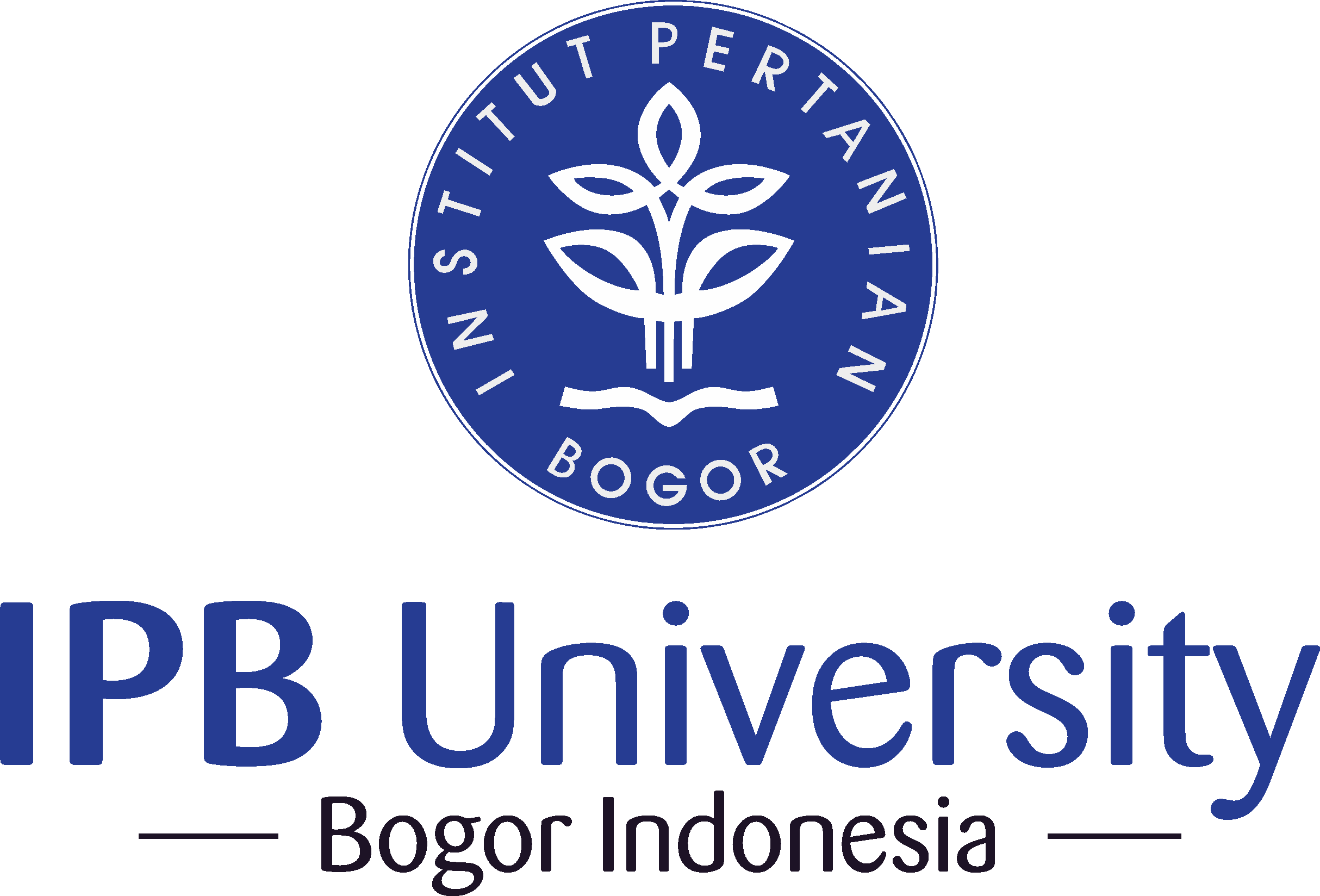Pemanfaatan Limbah Kultur Batch Bioreaktor dan Biochar untuk Meningkatkan Kesuburan Tanah
Abstract
The purpose of study was to determine the effects of aeration treatment on fish wastewater quality as a liquid organic fertilizer and fish wastewater watering treatment as a liquid organic fertilizer and a biochar application on nutrient content of lettuce and soil chemical properties. This study used a non factorial randomized block design. Treatments combination were watering freshwater frequency (W0: without watering; W1: watering twice a week; and W2: watering 4 times a week) and rice husk biochar dose (B0: without rice husk biochar; B1: 10 g rice husk biochar per polybag; and B2: 20 g rice husk biochar per polybag). The research parameters included: fish culture wastewater quality (pH, Biological Oxygen Demand, Chemical Oxygen Demand, NH3-N, NO3, NO2, Dissolved Oxygen, electrical conductivity, and temperature), plant nutrient content analysis (N, P, and K), and soil chemical analysis (pH, organic C, total N, C/N ratio, available P, and exchangeable K). The results showed that the quality of wastewater after aeration for 4 days met the water criteria to cultivate plants. The nutrient contents in the soil showed criteria for neutral soil pH, very low organic C, very low total N, medium C/N ratio, very high available P, and low exchangeable K. Although the nutrient content in the soil was low, the concentrations of N (1.87-3.08%), P (0.16-0.21%), and K (2.35-3.43%) nutrients in the plant were sufficient for lettuce growth. The combination treatment of watering wastewater 4 times a week and rice husk biochar 20 g per polybag gave better results to increase soil fertility and lettuce plant nutrients.
Keywords: liquid waste, plant nutrients, soil amendment, soil chemistry
Downloads
References
Balai Penelitian Tanah. 2009. Petunjuk Teknis Analisis Kimia Tanah, Tanaman, Air, dan Pupuk (Edisi 2). Bogor (ID): Balai Penelitian Tanah.
Brewer CE, Brown RC. 2012. Comprehensive Renewable Energy. Reference Module in Earth Systems and Environmental Sciences. 5: 357‒384. https://doi.org/10.1016/B978-0-08-087872-0.00524-2
Chandrasekhar, Pramada PN, Praveen L. 2005. Effect of organic acid treatment on the properties of rice husk silica. Journal of Materials Science. 40: 6535‒6544. https://doi.org/10.1007/s10853-005-1816-z
Chintala R, Schumacher TE, Kumar S, Malo DD, Rice JA, Bleakley B, Chilom G, Clay DE, Julson JL, Papiernik SK, Gu ZR. 2014. Molecular characterization of biochars and their influence on microbiological properties of soil. Journal of Hazardous Materials. 279(4): 244‒256. https://doi.org/10.1016/j.jhazmat.2014.06.074
Gani A. 2009. Potensi arang hayati biochar sebagai komponen teknologi perbaikan produktivitas lahan pertanian. Jurnal Iptek Tanaman Pangan. 4(1): 33-48.
Gross A, Bromm T, Glaser B. 2021. Soil organic carbon sequestration after biochar application: a global meta-analysis). Agronomy 11(12): 2474 https:// doi.org/10.3390/agronomy11122474
Habieb M, Zaitun, Sufardi. 2018. The effect of biochar and cow manure to increase soil fertility in Entisol Darussalam. International Journal of Agronomy and Agricultural Research.13(2): 1‒7.
Lubis N. 2013. Sistem Pertanian Terpadu. [Internet]. Tersedia pada: http://nasrillubis.blogspot.com/2013/06/sistem-pertanian-terpadu.html [diakses pada 14 Oktober 2018]
Mahler RL. 2004. Nutrients Plants Require for Growth. College of Agricultural and Life Sciences, University of Idaho. United States (US).
McLeod M, Sufardi, Zaitun, Sabaruddin, Nazariah, Ramlan, Devianti, Irhas, Ferizal, Dadd S. 2019. Final Report: Improving soil and water management and crop productivity of dryland agriculture systems of Aceh (Indonesia) and New South Wales (Australia). Project number SMCN/2012/103. Australian Centre for International Agricultural Research (ACIAR). 96 p.
Pandit NR, Mulder J, Hale SE, Zimmerman AR, Pandit BH, Cornelissen G. 2018. Multiyear double cropping biochar field trials in Nepal: finding the optimal biochar dose through agronomic trials and cost-benefit analysis. Elsevier Journal of Science of the Total Environment. 637‒638: 1333‒1341. https://doi.org/10.1016/j.scitotenv.2018.05.107
Persson TBE, Clarholm M, Lundkvist H, Söderström BE, Sohlenius B. 1980. Trophic structure, biomass dynamics and carbon metabolism of soil organisms in a scots pine forest. Ecological Bulletins No. 32 419‒459.
Plank CO, Kissel DE. 2022. Plant Analysis Handbook. College of Agricultural and Environmental Sciences. Athens, GA 30602, United States (US): University of Georgia.
Rivka B, Laird D, Thompson M, Lawrinenko M. 2017. Characterization and quantification of biochar alkalinity Chemosphere. 167: 367‒373. https://doi.org/10.1016/j.chemosphere.2016.09.151
Samira, D, Sufardi, Zaitun, Chairunas, Gani A. 2013. Improving Soil Chemical Properties by NPK Fertilizer Application and Residual Rice Husk Biochar Effect on Irrigation Paddy Field. In: Proceeding of The 3rd Annual International Conference Syiah Kuala University in conjuction with The 2nd International Conference on Multidisciplinary Research. Banda Aceh (ID): pp. 371‒374.
Shen Y, Peitao Z, Qinfu S. 2014. Porous silica and carbon derived materials from rice husk pyrolysis char. J. Microporous and Mesoporous Materials 188(2014): 46‒76. https://doi.org/10.1016/ j.micromeso.2014.01.005
Singh C, Tiwari S, Gupta VK, Singh JS. 2018. The effect of rice husk biochar on soil nutrient status, microbial biomass and paddy productivity of nutrient poor agriculture soils. Elsevier Journal of Catena. 171: 485‒493. https://doi.org/10.1016/j.catena.2018.07.042
Subandi. 2013. Peran dan pengelolaan hara kalium untuk produksi pangan di indonesia1 (role and management of potassium nutrient for food production in Indonesia). [Internet]. Tersedia pada: https://media.neliti.com/media/publications/30881-ID-role-and-management-of-potassium-nutrient-for-food-production-in-indonesia.pdf. [Diakses pada 30 Mei 2021].
Sufardi. 2012. Introduction to Plant Nutrition. Universitas Syiah Kuala. Banda Aceh (ID): CV. Bina Nanggroe.
Suárez-Hernández L, Ardila-A AN, Barrera-Zapata R. 2017. Morphological and physicochemical characterization of biochar produced by gasification of selected forestry species. Revista Facultad de Ingeniería. 26(46) 123‒130. https://doi.org/ 10.19053/01211129.v26.n46.2017.7324
Tan Z, Lin CSK, Ji X, Rainey TJ. 2017. Returning biochar to fields: A Riview. Applied Soil Ecology 116 1‒11. https://doi.org/10.1016/j.apsoil.2017.03. 017
Yunilasari M, Sufardi, Zaitun. 2020. Effects of biochar and cow manure on soil chemical properties and peanut (Arachis hypogaea L.) yields in entisol. In: Proceeding of IOP Conference Series: Earth and Environmental Science. 425: 012014. https://doi.org/10.1088/1755-1315/425/1/012014
Zaitun Z, Halim A, Sa’dah N, Cahyadi R. 2022. Surface morphology properties of biochar feedstock for soil amendment. In: Proceeding of IOP Conference Series: Earth and Environmental Science. 951: 012034. https://doi.org/10.1088/1755-1315/951/1/012034
This journal is published under the terms of the Creative Commons Attribution-NonCommercial 4.0 International License. Authors who publish with this journal agree to the following terms: Authors retain copyright and grant the journal right of first publication with the work simultaneously licensed under a Creative Commons Attribution-NonCommercial 4.0 International License. Attribution — You must give appropriate credit, provide a link to the license, and indicate if changes were made. You may do so in any reasonable manner, but not in any way that suggests the licensor endorses you or your use. NonCommercial — You may not use the material for commercial purposes.























